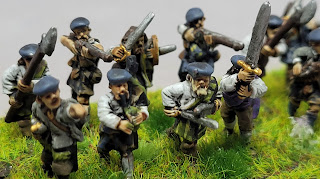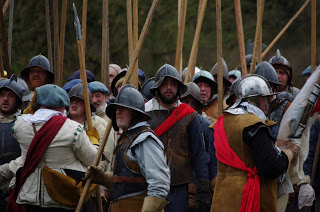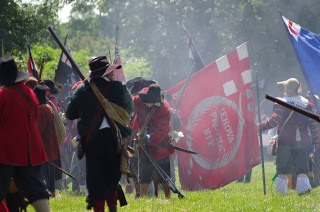Houses of Interest: Borders
The latest instalment of the ECWtravelogue summer road trip. This time attention turns to the Borders.
The Battle of Philiphaugh was fought on 13th September 1645, to the south west of Selkirk.After Montrose's victory at Kilsyth in August 1645, he made a critical error: rather than pressing on and consolidating his gains, he allowed his army to disperse, giving his enemies a chance to regroup.
 |
| the battlefield from the walkway |
Montrose appeared to be unaware that Leslie had marched north from England with a substantial Covenanter army. On the 11th, Leslie had joined forces with the Lothian troops at Gladsmuir and then proceeded south. On night of the12th, unbeknownst to Montrose, the Covenanter army advanced toward Selkirk, disrupting the quarters of Montrose's rear guard. His seriously outnumbered army was taken by surprise by the advancing Covenanter forces, who routed Montrose's army from the field. The defeat marked the end of Montrose’s effective campaign in Scotland.
 |
| the battlefield from the Salmon Viewing Centre |
The fleeing men of Montrose's army were cut down as they fled westwards; 300 Irish troops who had surrendered to the Covenanters on promise of quarter were slaughtered at nearby Newark Castle.
Cue wibbly going back in time effect...
Charles I attempted to impose Episcopalianism on Scotland, and the English Liturgy was preached at St Gile's High Kirk, Edinburgh. At that point things went truly south for Charles, and the Scots rioted. A Covenanting army led by General Alexander Leslie took up camp on Duns Law under the command of General Alexander Leslie who later became the first Earl of Lennox.
The army converged on the Law in two Divisions, one from Dunglass and one from Kelso, where they had been watching the approaches from England of the Royalist Army under Charles I who was determined to compel the Scotsto adopt Episcopacy.
What's there now?
Montrose spent night at 1-3 West Port in Selkirk: he was said to be at his breakfast when Captain Blackadder (resists the urge to make a Rowan Atkinson Blackadder reference) burst in to tell him that the Covenanters had begun their attack on the nearby field of Philiphaugh. A plaque marks the spot.
A battlefield memorial was established close to one of the entrances to Selkirk FC by the Montrose Society.
 |
| needs a good clean |
This memorial also marks the start of an interpretative battlefield walk which runs from the football club, adjacent to the A708, towards the Salmon Viewing Centre.
 |
| board 1 |
 |
| board 2 |
 |
| board 3 |
 |
| board 4 |
 |
| board 5 |
 |
| board 6 |
 |
| board 7 |
There are seven interpretive panels, along the walk, which overlooks the battlefield. The walk is rather badly drained and very overgrown, so perhaps don't wear you best shoes.
There's more information about the battle at the Salmon Viewing Centre.
A much older Covenanter memorial is located on the Philiphaugh estate, self-guided walks start at the Salmon Viewing Centre, where maps are available.
The Estate does, from time to time put on guided walks of the battlefield.
Heading west from the Salmon Viewing Centre along the A708 will bring you to an area marked on maps as Slain Men's Lea, where considerable human remains were found, believed to be from Montrose's Army.
 |
| Newark Castle |
Newark Castle is located on the neighbouring Bowhill Estate: parking is available at General's Bridge Car Park (booking recommended). The walk to the castle will take you over Slain Men's Lea, the area around Newark Burn. A map can be downloaded, providing a route for the 3 mile Lady's Walk.
>>>>>>>>>>>>>>>>>>>>>>>
 |
| Neidpath Castle |
Neidpath Castle, Peebles, was initially garrisoned by the Covenanters against Montrose in 1645 by Lord Yester. Yester changed allegiance in 1646. During Cromwell's invasion of Scotland in 1650, Neidpath was besieged, the 13th-century tower was demolished by artillery fire, along with parts of the west wing.
Neidpath is now a wedding venue, and holiday accommodation.
 |
| Hume Castle's comedy crenellations |
Hume Castle, Kelso, was also besieged during the Anglo-Scots War: Cromwell ordered Colonels Fenwick and Slyer to take the castle, which was garrisoned with 300 men under the command of Colonel John Cockburn.
Cockburn had fought for the Covenant Army that had supported Parliament, but had become an Engager. At the start of the siege, when called upon to surrender, Cockburn is reported to have replied "I know not Cromwell. And as to my castle, it stands upon a rock!".
Cockburn refused to surrender, often taunting his besiegers. However, once the resumed bombardment had breached the castle walls and rendered the castle's defence hopeless, Cockburn surrendered the castle with quarter given for its surviving defenders.
Hume was slighted, but rebuilt, with preposterously large crenellations, in the late 18th Century as a folly.
 |
| Fast Castle |
Fast Castle is the ruined remains of a coastal fortress in Berwickshire: it was taken by the Commonwealth in 1651 after a short siege.
Duns Law effectively saw the Covenanter movement turn into a military movement. Leslie is traditionally reported to have raised the Covenanter standard at a stone close on the site of an iron age hill fort. The stone he is reputed to have raised the standard on is protected by a metal grill, with a modern memorial cairn adjacent to it. There are also possible C17th defensive earthworks on the site too. Access to the site can only be gained on foot, using the footpath (uphill) from the Castle Street entrance to Duns Castle estate.
Charles I attempted to impose Episcopalianism on Scotland, and the English Liturgy was preached at St Gile's High Kirk, Edinburgh. At that point things went truly south for Charles, and the Scots rioted. A Covenanting army led by General Alexander Leslie took up camp on Duns Law under the command of General Alexander Leslie who later became the first Earl of Lennox.
The army converged on the Law in two Divisions, one from Dunglass and one from Kelso, where they had been watching the approaches from England of the Royalist Army under Charles I who was determined to compel the Scotsto adopt Episcopacy.
 |
| the Covenanter Stone |
The Standard of the Covenant was hoisted on the stone known as the Covenanters Stone
On this stone according to unbroken tradition was raised the Standard of the Covenanters when in 1639 their army under General Sir Alex Leslie assembled on Duns Law
The result however was not battle but stand-off. Envoys were sent between the two Camps and a 'Pacification' was arranged in terms of which the Covenanting Army was disbanded and the Royalist army withdrew from the Borders.
 |
| Duns Castle |
A copy of the Covenant was signed at Duns Castle, and is still preserved there. The Castle is a wedding venue, restaurant and has self-catering holiday lets. It is not otherwise open to the public.
Postcodes for SatNavs
Montrose Plaque, 1-3 West Port, Selkirk TD7 4DGBattlefield Memorial, close to entrance to Selkirk FC, TD7 5AX
Battlefield walkway Selkirk FC - Salmon Viewing Centre TD7 5AX - TD7 5LU
Battlefield walkway Selkirk FC - Salmon Viewing Centre TD7 5AX - TD7 5LU
Salmon Viewing Centre, Philiphaugh Estate, Selkirk TD7 5LU
General's Bridge car park (for Slain Men's Lea & Newark Castle), Bowhill Estate TD7 5ET
Neidpath Castle, Peebles EH45 8NW
Hume Castle, Kelso TD5 7TR
Hume Castle, Kelso TD5 7TR
Fast Castle, Dowlaw Rd, Eyemouth TD14 5TY
Duns Law, Duns TD11 3SZ
If you enjoyed reading this, or any of the other posts, please consider supporting the blog.
Thanks.









.jfif)





Comments
Post a Comment